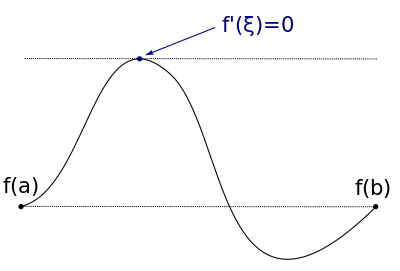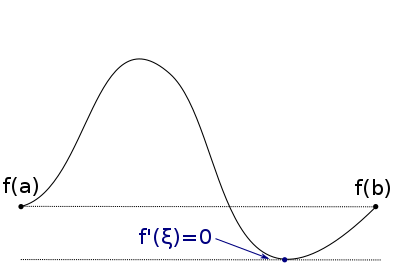Math for Non-Geeks/ Rolle's theorem
{{#invoke:Math for Non-Geeks/Seite|oben}}
Motivation
File:Satz von Rolle – Veranschaulichung und Erklärung.webm We already know from the extreme value theorem that a continuous function attains a maximum and a minimum on a closed interval :

This is of course also true, if . In this case (if the function is not constant) there must be a maximum or minimum inside the domain of definition. In the following figure, both the maximum and the minimum are inside , i.e. within the open interval :

Let us now additionally assume that is differentiable on . Let be a maximum or minimum. If is inside the domain of definition, i.e. if , then according to the main criterion for extremes values of a differentiable function. This means that the tangent to at is horizontal. This is exactly what Rolle's theorem says: For every continuous function with , which is differentiable at , there is an argument with .
-
The derivative at the maximum of is zero.
-
The derivative at the minimum of is zero.
Of course, can also assume several (partly local) maxima and minima on . Furthermore, it is possible that attains only one maximum (and no minimum) or one minimum (and no maximum) on :
-
The function attains one maximum and no minimum within its domain of definition. At that point, the derivative is zero.
-
The function attains one minimum and no maximum within its domain of definition. At that point, the derivative is zero.
A special case is being constant on . In this case there is for all :

This may also happen on a finite sub-interval of , i.e. on a "horizontal plateau".
No matter which case we looked at, there was always at least one point inside the domain of definition where the derivative of the function is zero.
Rolle's theorem
File:Satz von Rolle - Quatematik.webm The theorem named after Michel Rolle (1652-1719) represents a special case of the mean value theorem of differential calculus and reads as follows:
Math for Non-Geeks: Template:Satz
Math for Non-Geeks: Template:Frage
About conditions used in the theorem
There are several necessary requirements in Rolle's theorem. We will show now that if we drop any one of them, the theorem is no longer true.
Condition 1: is continuous on
Math for Non-Geeks: Template:Aufgabe
Condition 2: :
Math for Non-Geeks: Template:Aufgabe
Condition 3: is differentiable on :
Math for Non-Geeks: Template:Aufgabe
Proof
Math for Non-Geeks: Template:Beweiszusammenfassung
Math for Non-Geeks: Template:Beweis
Exercise
Math for Non-Geeks: Template:Aufgabe
Application: Zeros of functions
Rolle's theorem can also be used in proofs of existence of zeros. And it can be used to show that a function has at most one zero on an interval. On the other hand, the intermediate value theorem can be used to show that a function has at least one zero on an interval. Together the existence of exactly one zero can be implied.
Math for Non-Geeks: Template:Beispiel
Further exercise
Math for Non-Geeks: Template:Aufgabe
Outlook: Rolle's theorem and the mean value theorem
As mentioned above, Rolle's theorem is a special case of the mean value theorem. This is one of the most important theorems from real Analysis, as many other useful results can be derived from it. Conversely, we will show that the mean value theorem follows from Rolle's theorem. Both theorems are thus equivalent.
{{#invoke:Math for Non-Geeks/Seite|unten}}



